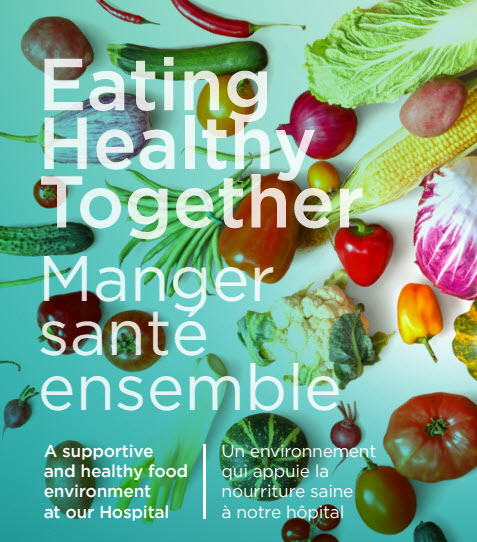Hospital’s retail food environment to change for the healthier
by Sara Chow
 “Thunder Bay Regional Health Sciences Centre’s Eating Health Together Strategy aims to re-engineer the retail food environment at our Hospital to create a supportive and healthy retail environment. Our primary focus is to remove all ultra-processed food and increase access to and availability of minimally processed and unprocessed foods,” says Kelly-Jo Gillis, Manager of Preventive Health Services with Prevention and Screening Services.
“Thunder Bay Regional Health Sciences Centre’s Eating Health Together Strategy aims to re-engineer the retail food environment at our Hospital to create a supportive and healthy retail environment. Our primary focus is to remove all ultra-processed food and increase access to and availability of minimally processed and unprocessed foods,” says Kelly-Jo Gillis, Manager of Preventive Health Services with Prevention and Screening Services.‘Would you like a side of fries to go with your angioplasty?’ said no healthcare provider ever.
Diet is the second leading risk factor for death and disease, and hospitals are on the front line for medical treatment required to treat diet-related illnesses and disease. So, why would a hospital sell food that contributes to the very conditions it treats?
“Thunder Bay Regional Health Sciences Centre’s Eating Health Together Strategy aims to re-engineer the retail food environment at our Hospital to create a supportive and healthy retail environment,” says Kelly-Jo Gillis, Manager of Preventive Health Services with Prevention and Screening Services. “We know that education alone is not enough to help people make the healthier choice, and that the food available in your surroundings plays a large role in daily food decisions.”
The Eating Healthy Together Strategy leveraged best practice evidence, engagement with the public and staff, and expertise from clinical professionals to develop a strategy to improve the retail food environment at our Hospital. “Together, our team created very comprehensive guidelines called ‘Nutrition Standards’ that ultimately define what is and isn’t allowed for sale at our Hospital based on nutrition. Our primary focus is to remove all ultra-processed food and increase access to and availability of minimally processed and unprocessed foods,” explained Gillis.
The concept of categorizing foods by how natural they are, as opposed to processed, originates from the Dietary Guidelines for the Brazilian Population. It defines unprocessed/minimally processed foods as those obtained directly from plants or animals, and those that have been cleaned, ground, dried, fermented, pasteurized, cooled, frozen or had inedible or wanted parts removed but have not had oils, fats, sugar or salt added (i.e. an apple). Whereas ultra-processed foods are those that are made of industrial ingredients and other substances derived from foods, plus additives (i.e. apple flavoured candy). You can think of the degree of processing as how much the food looks like its original form (i.e. does a hot dog look like it came off of a pig?).
Creating a healthy nutrition environment, following the Nutrition Standards, encourages and influences healthy lifestyles, which is key for the prevention of diseases. It supports people to make good eating choices, especially when their health is critical enough to be at a hospital. In our region, it is common knowledge that chronic disease rates are higher than the rest of the province; it’s time for the hospital to take a leading role in population health improvement by serving a side of salad to complement your care.
For more information on the Eating Healthy Together strategy at our Hospital, visit: www.tbrhsc.net/eatinghealthytogether.